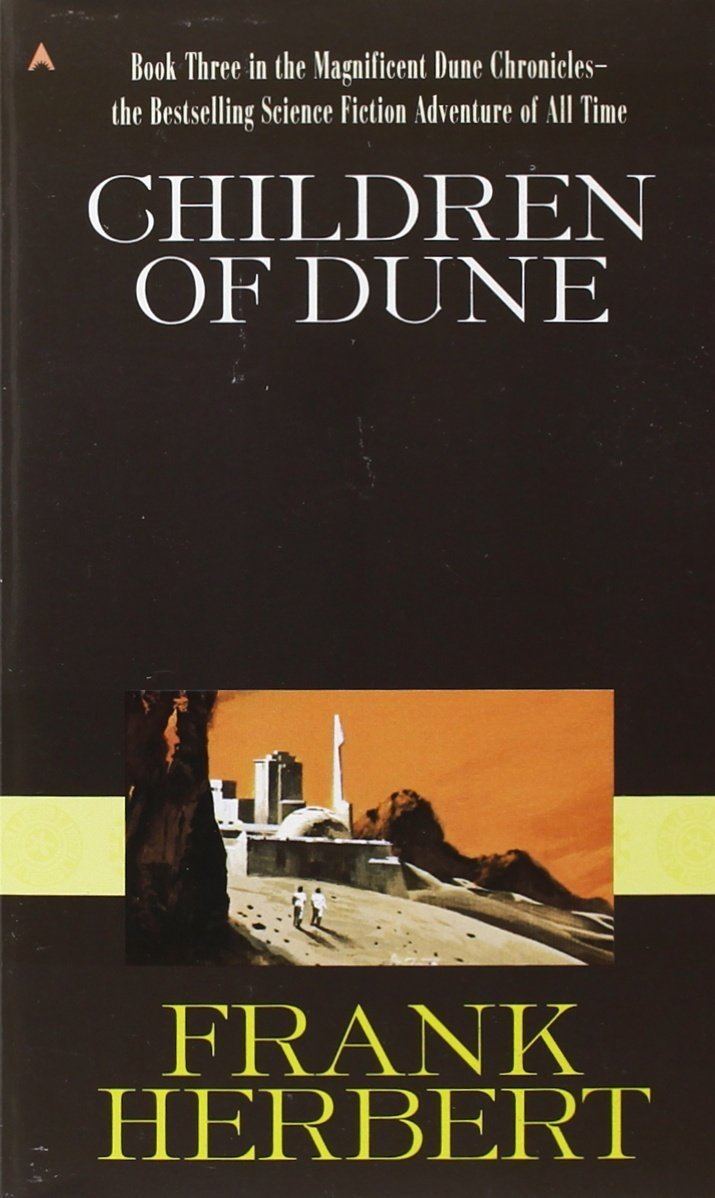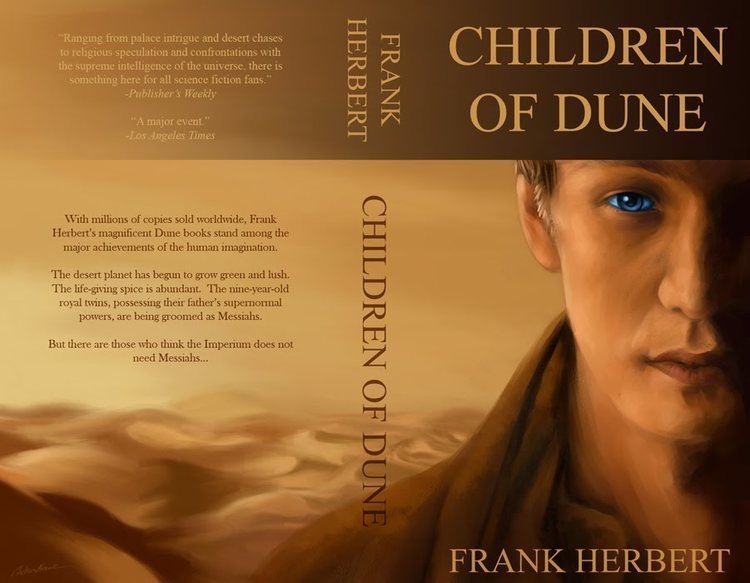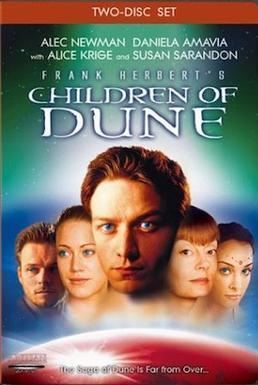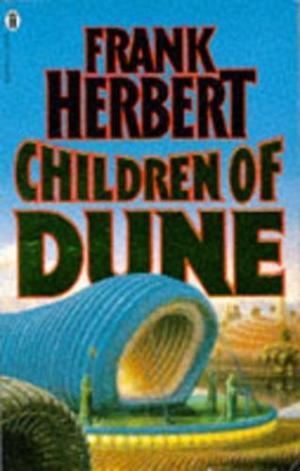7.6 /10 1 Votes
First episode date 16 March 2003 Network Syfy | 7.6/10 IMDb Music by Brian Tyler Final episode date 18 March 2003 | |||||||||||||||||||||||||||||||||
 | ||||||||||||||||||||||||||||||||||
Starring James McAvoyAlec NewmanJulie CoxDaniela AmaviaAlice KrigeSusan Sarandon Cast | ||||||||||||||||||||||||||||||||||
Frank Herbert's Children of Dune is a three-part science fiction miniseries written by John Harrison and directed by Greg Yaitanes, based on Frank Herbert's novels Dune Messiah (1969) and Children of Dune (1976). First broadcast in the United States on March 16, 2003, Children of Dune is the sequel to the 2000 miniseries Frank Herbert's Dune (based on Herbert's 1965 novel Dune) and produced by the Sci Fi Channel. As of 2004, this miniseries and its predecessor were two of the three highest-rated programs ever to be broadcast on the Sci-Fi Channel.
Contents

In 2003, the critically acclaimed miniseries won a Primetime Emmy Award for Outstanding Special Visual Effects.
Part One

Twelve years have passed since Paul Atreides had become Emperor at the end of Frank Herbert's Dune by seizing control of the planet Arrakis and forcing a union with the former Emperor's daughter, the Princess Irulan. Paul's Fremen armies have since launched several bloody jihads to solidify his position. Deposed Emperor Shaddam IV and the rest of his family are exiled to Salusa Secundus, where his other daughter Princess Wensicia plots to restore House Corrino to power. The Bene Gesserit, the Spacing Guild, and the Tleilaxu also plot to overthrow Paul's reign, aided even by rebel Fremen, who hate how Paul's terraforming project is changing Arrakis and the traditional Fremen way of life. The Tleilaxu present Paul with a ghola in the likeness of his friend Duncan Idaho, killed during the events of Dune, but secretly conditioned to assassinate Paul when triggered by certain words.

Though his prescient abilities reveal the dangers ahead, Paul allows the conspiracies to succeed to avoid even worse consequences. He is attacked with a type of nuclear weapon called a stone burner and blinded, but still manages to "see" by following his prescient visions. Later, Paul's concubine Chani gives birth to twins at a Fremen sietch but dies soon afterward. In Paul's absence, his sister Alia purges the imperial city of the enemies of House Atreides. Meanwhile, the Tleilaxu Face Dancer Scytale triggers Duncan's conditioning; but the trauma of potentially killing Paul breaks his programming, and unlocks the memories of his original incarnation. His plan foiled, Scytale threatens the lives of Paul's children; whereupon the unique nature of the infants (who, like Alia, were "pre-born") allows Paul to see through the eyes of his son and kill Scytale. Following the Fremen tradition of abandoning the blind to the sandworms, Paul walks alone into the desert. His legacy secured, the twins and their future empire are now left in the care of Alia.
Part Two

Paul's and Chani's children Leto II and Ghanima are now young adults; Princess Irulan has protected their interests as her own. Now married to Duncan, Alia is still regent of Paul's empire and official guardian of the children. Irulan's sister Wensicia yearns for a return to power through her son, Farad'n. After a long absence, Paul and Alia's mother Lady Jessica arrives on Arrakis to visit her family, but Alia fears that Jessica has resumed her allegiance to the Bene Gesserit and may be plotting against her. An individual known as "The Preacher" has surfaced in the capital, speaking against the decline of Muad'Dib's religion into fear and ritualism; but Alia resists having him killed because she shares the popular belief that he may be a returned Paul.

Alia possesses the memories and personalities of her ancestors due to being pre-born, but has trouble controlling them; her internal struggles against the assertive voices manifest themselves in the form of paranoia and self-destructive behavior. The persona of the evil Baron Vladimir Harkonnen, Alia's maternal grandfather whom she had herself killed, begins to influence her, and threatens to overtake Alia's consciousness altogether. Jessica senses that Alia has become dangerous, and advises Irulan to spirit Leto and Ghanima away to safety. Later, after an assassination attempt on her, Jessica seeks sanctuary with Fremen dissidents. Wearing clothes presented to them by Wensicia, the twins escape into the deep desert but are soon cornered in a deadly trap of her devising.
Part Three

Wensicia's plot to assassinate the Atreides heirs fails, but provides Leto an opportunity to fake his own death and buy time to overcome Alia. Alia's madness reaches its peak as Baron Harkonnen's grip on her consciousness strengthens and a civil war brews with the rebel Fremen. Leto returns from the deep desert, having used sandtrout — the larval form of Arrakis' sandworms — to acquire the superhuman speed, strength, and invulnerability of the sandworms themselves.
As a means of forcing as-yet-neutral Fremen leader Stilgar to lead the rebels, Duncan murders Alia's lover Javid in Stilgar's sietch; Duncan knows that, according to Fremen custom, Stilgar must revenge-kill him, which will force Stilgar into active opposition to Alia. Leto encounters the Preacher, whose identity as his father is revealed. Leto's prescient visions have convinced him that he must lead mankind along "the Golden Path" to ensure humanity's ultimate survival.
With a political marriage arranged by Jessica between Ghanima and Wensicia's son Farad'n, the Corrino heir identifies his mother as the mastermind behind Leto's apparent death. Alia has Wensicia imprisoned, but Ghanima accepts Farad'n's gesture as honest. With Stilgar's forces moving in, father and son return to the capital city of Arrakeen, where the Preacher makes a final speech denouncing Alia and his own religion, and is fatally stabbed by a rebel Fremen. Leto confronts Alia at Ghanima's wedding and defeats her. Alia then commits suicide rather than be controlled by the Baron. In the final scene, Ghanima tells Farad'n that while he will not be her husband, they may yet fall in love, and how she pities her brother for the pain and suffering he will endure in the long life he must expect.
Development
Acquiring the television rights to Frank Herbert's original six Dune novels, Executive producer Richard P. Rubinstein envisioned the complex material adapted in a miniseries format, as he had done previously with Stephen King's The Stand and The Langoliers. He told The New York Times in 2003, "I have found there's a wonderful marriage to be had between long, complicated books and the television mini-series. There are some books that just can't be squeezed into a two-hour movie." Around the same time Rubenstein was first developing the material, the Sci Fi Channel's president, Bonnie Hammer, was spearheading a campaign for the channel to produce "blockbuster miniseries on a regular basis". Frank Herbert's Dune was the first in 2000, followed by Steven Spielberg's Taken in 2002, and Frank Herbert's Children of Dune and Battlestar Galactica in 2003.
Rubenstein called his two Dune miniseries "science fiction for people who don't ordinarily like science fiction" and suggested that "the Dune saga tends to appeal to women in part because it features powerful female characters". Actress Sarandon agreed, saying "One of the reasons I always loved the books was because they were driven by strong women, living outside the rules." She added that the Dune series "is very apropos to some of what's going on in the world today. It's about the dangers of fundamentalism and the idea that absolute power corrupts." Sarandon said of portraying Wensicia, "it's always fun to play a smart villain."
Adaptation
After production completed on the first miniseries (and before its broadcast), the Sci Fi Channel contracted writer/director Harrison to write a sequel. Harrison's idea for the next installment was to combine Frank Herbert's subsequent novels, Dune Messiah and Children of Dune. He has said in interviews that he believed both novels to be two parts of the same story, which essentially concludes the story of House Atreides. The novel Dune Messiah is a shorter novel than either Dune or Children of Dune.
Reception
Laura Fries of Variety cited the complexity of Herbert's novels and called the adaptation "decidedly more accessible—even if that means more soaplike". Melanie McFarland of the Seattle Post-Intelligencer called the miniseries "exciting to watch", adding that "common couch potatoes will delight in the show's dark operatics, especially when cloaked in exquisite special effects" and that "Herbert devotees should be pleased with the outcome". McFarland noted that, though complex, "Children of Dune doesn't feel weighed down by its ponderous story line, where its predecessor did". Ron Wertheimer of The New York Times, however, wrote, "Subtlety? Nuance? No and no. The plot ... doesn't always make sense. The film ... unfolds more as a pageant than as a coherent narrative."
According to Fries, "it’s Susan Sarandon and Alice Krige who steal the thunder as opposing matriarchs of the great royal houses. Although the two never catfight, their ongoing struggle to rule the Dune dynasty gives this mini a real kick." Observing that Sarandon and Krige were "clearly relishing their roles", Fries added that "Sarandon makes a formidable enemy, while Krige, traditionally cast as the villain, proves she can work both sides of the moral fence." McFarland concurred, writing "[Sarandon's] princess may be the villain, cooking up deadly schemes, but we're right along with her in having a good time." Stating that the acting "is at best utilitarian, the universally attractive performers embody attributes, not people", Wertheimer added:
The exception is the piece's token movie star ... Susan Sarandon, having a high old time as the villain. Looking swell in slinky gowns and a collection of outer-space-deco headgear fitted with sensual silver antennas, Ms. Sarandon nearly winks into the camera. Her body language, her purring tone, the gleam in her evil eye, the curve of her evil eyebrow all declare, "Isn't this a hoot?" In another film, such a jarring note from a principal would sink it. But she's right; this is a hoot. Her mugging is part of the fun.
While Fries continues that "the mini picks up a great deal of charisma when McAvoy and Brooks come aboard as the next generation of the house of Atreides" and that "Amavia and Cox as the tortured Alia and the put-upon Irulan offer layered performances", she also adds that "Newman, as the sour Paul, sticks to just one note". McFarland writes, Children of Dune's only annoyance is in the cast's insistence upon inexpressive acting. Fear may be the mind killer, but in this show power serves emotional strychnine—the more royal the character, the stiffer the expression.
Fries also praised the miniseries' visual effects and costumes, and Wertheimer wrote, "The best qualities of the earlier film are matched in its successor: the eye-filling vistas, the over-the-top sets and costumes, the nifty effects, all of them light years beyond standard made-for-television fare." McFarland agreed, writing "What really keeps you engaged are Ernest Farino's special effects. He won an Emmy for his efforts on Dune, and tops that accomplishment here. The visuals are so incredible they demand a large screen viewing."
Soundtrack
The series' score, containing 36 tracks, was written by Brian Tyler in a span of one month, and is considered one of Tyler's best scores. The lyrics of the track "Inama Nushif" are sung by Azam Ali. The music has been reused in several theatrical trailers, including Master and Commander: The Far Side of the World, The Chronicles of Narnia: The Lion, The Witch and The Wardrobe, Cinderella Man, Kung Fu Panda, The Golden Compass, Indiana Jones and the Kingdom of the Crystal Skull, and Star Trek.
